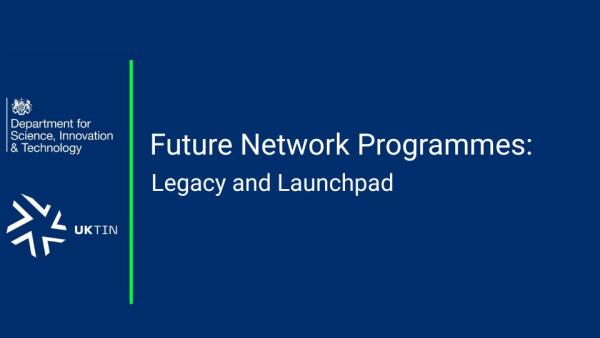
As connectivity becomes crucial for business, industry, and society, the UK's Department for Science, Innovation, and Technology (DSIT) seeks innovative solutions through its Open Network Programmes. These programmes are designed to advance communication technologies by fostering innovation, diversifying the UK’s 5G infrastructure, and preparing for the next generation of mobile networks.
Central to these efforts is a diverse array of projects focused on advancing technologies such as Open RAN, private 5G networks, and AI-driven automation. These initiatives collectively aim to accelerate the development of flexible, scalable, and secure networks capable of serving a wide range of industries and applications.
In March, the programme celebrated a milestone in the Future Network Programmes at the Connected Reflections event, highlighting the progress made across the portfolio of projects over the past four years. With some of these projects receiving extensions, they are now positioned to further refine and expand their work, driving forward the vision of a connected future.
Driving Innovation in Network Flexibility and Efficiency
The extension of these projects comes at a time when the demand for more dynamic and adaptable networks has never been higher. Many of the initiatives under the Open Network Programmes are focused on enhancing private 5G networks, exploring how they can be deployed in various industries and environments—from urban centres to large-scale venues. For instance, the ONSIDE project has been testing private 5G standalone networks across Glasgow and other parts of the UK, experimenting with portable 5G units and establishing key test sites. These deployments are helping to refine how private networks can better serve industries like healthcare, manufacturing, and logistics by providing high-capacity and secure communication channels.
These projects are also harnessing the power of Open RAN, which offers greater flexibility by enabling network components to be sourced from multiple vendors, creating an open, interoperable ecosystem. This approach contrasts with traditional, proprietary networks, enabling faster innovation, cost efficiencies, and more tailored solutions for specific use cases. The SONET project, for example, has been deploying Open RAN solutions around the Stadium of Light and an esports arena, demonstrating how Open RAN can deliver high-performance networks in environments with very high connectivity demands. Through this work, they are showing how intelligent network management can help these venues handle complex, real-time applications like immersive event experiences and video analytics for public safety.
Exploring the Potential of 5G and Beyond
Many of the projects are focused on creating advanced testbeds to trial the capabilities of 5G and 6G technologies in real-world settings. By building and testing private 5G networks across various sites, the programmes are pushing the boundaries of how 5G can be used in sectors like healthcare, logistics, manufacturing, and more. Projects like SCONDA are playing a pivotal role in developing Open RAN technologies, particularly through small cell deployments in Glasgow. The extension of this work will focus on developing new 6G network architectures, incorporating artificial intelligence for network automation, and exploring new optical technologies for more efficient data transmission.
These tests are not just about the technology itself, but also about developing better tools for spectrum management, ensuring that these networks are efficiently using the available radio spectrum in ways that benefit both industry and consumers. The ONSIDE project is at the forefront of this effort, experimenting with automated spectrum management and co-existence testing to ensure that the UK’s 5G networks operate with minimal interference while offering the best possible performance.
Enabling Interoperability and Open Standards
In addition to technical innovations, these programmes are deeply committed to fostering collaboration across the telecom ecosystem. A central focus has been on creating environments where Open RAN vendors, system integrators, and operators can come together to test and validate the interoperability of open network solutions. For example, SONIC Labs, led by Digital Catapult in partnership with Ofcom, has created a platform for testing Open RAN technologies. The programme has already conducted over 70 tests and worked with more than 20 vendors to verify the performance of open network solutions.
REASON has been pushing boundaries in its effort to combine academic and industrial research. Its outcomes are impacting open source standards as well as the 3GPP Release and has won the National AI Award for High Tech & Telecom.
By creating testing environments, these projects provide the real-world environments necessary to develop open standards for next-generation networks. The ultimate goal is to create a flexible, interoperable network infrastructure where components from different vendors can seamlessly work together, offering greater choice and resilience. Through its extension, the work being done in SONIC Labs and similar initiatives will continue to promote the development of open standards, which will be critical to the future of 5G and 6G networks.
Innovative Telecoms Networks for Sustainability and Automation
As networks become more complex and feature-rich, the role of AI and machine learning becomes ever more critical. Several projects are exploring how AI-driven applications can enhance the automation and optimisation of network management. The ARIANE project, for example, has been focusing on evaluating the impact of AI/ML applications in multi-RIC environments within Open RAN architectures. These innovations allow networks to autonomously adjust based on real-time traffic demands, improving overall efficiency and performance.
Moreover, as sustainability becomes an ever-pressing concern, many of these projects are also turning their focus toward energy management in telecom networks. The ARIANE project is investigating how energy-efficient practices can be integrated into Open RAN deployments, exploring use cases like MIMO mode reconfiguration to reduce power consumption without compromising performance. These efforts aim to make telecom infrastructure more sustainable, helping to align the telecom industry with global goals around carbon neutrality.
Building a Collaborative Ecosystem
One of the overarching themes of the Open Network Programmes is the drive to create a more collaborative ecosystem within the UK’s telecom sector. By bringing together government bodies, industry leaders, academics, and researchers, these programmes are laying the groundwork for future telecom standards, while also promoting the commercialisation of advanced telecom technologies. The UK's vision for the future of telecom is built on fostering an environment where public and private sector collaboration can lead to breakthroughs that will benefit society as a whole.
UKTIN will continue its work focusing on promoting the UK’s telecom capabilities domestically as well as internationally, helping to integrate the UK into global telecom standards and Horizon Europe initiatives.
As these projects continue to evolve, their influence will extend far beyond the confines of their testbeds and pilot deployments. For instance, the YO-RAN project, which is working on neutral host networks, is developing low-cost radio units that support infrastructure sharing between multiple operators, offering a more cost-effective approach to building telecom networks.
Conclusion: A New Era of Connectivity
The conclusion of the Open Network Programmes marks both a moment of reflection and a look forward. While some projects have successfully reached their completion, the extended initiatives continue to lead the way in driving innovation and fostering collaboration within the telecom sector. These ongoing efforts are set to achieve new milestones in creating more flexible, sustainable, and interoperable networks that meet the demands of industries and consumers alike.
To delve deeper into the transformative work these extended projects are pursuing and to stay updated on their progress, we encourage you to explore their dedicated project pages.









